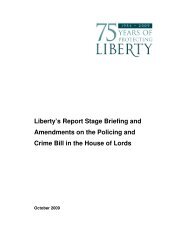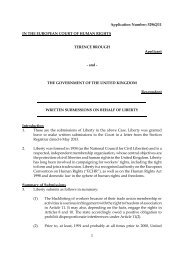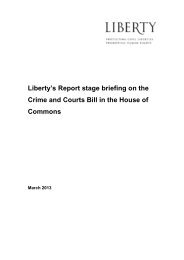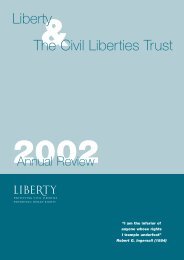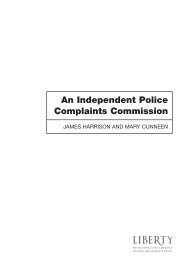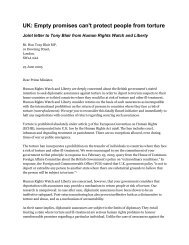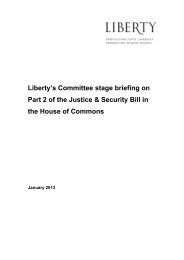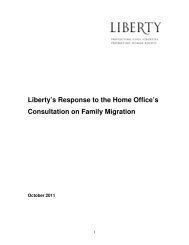Overlooked - Liberty
Overlooked - Liberty
Overlooked - Liberty
You also want an ePaper? Increase the reach of your titles
YUMPU automatically turns print PDFs into web optimized ePapers that Google loves.
106 <strong>Overlooked</strong>: Surveillance and personal privacy in modern Britain<br />
patterns arising from data matching or data mining might not justify or legitimise the use of human<br />
surveillance or reference to the police for investigation. However, it is more likely to satisfy the more<br />
easily achievable requirements of accessing communications data. ‘More easily achievable’ in this<br />
context can be taken to mean both in terms of the legal grounds justifying the accessing of<br />
communications data and in terms of the resource that will be necessary to ‘investigate’ further.<br />
Once an application for access to communications data has been authorised, this will allow access<br />
to email, mobile and phone traffic which might take investigation further. If for example, it appears<br />
that a series of calls or emails have been made to individuals who are themselves suspected of<br />
involvement in criminal activity, then a greater level of intelligence-led investigation might be<br />
considered necessary. If, however the communications data does not reveal any unusual traffic, then<br />
no further action might be considered necessary. It is, however, extremely unlikely that the person<br />
who had had his or her communication traffic studied will be aware of the fact. The sheer number<br />
of applications made coupled with involvement after the event limits any practical involvement of, or<br />
accountability to, the Interception of Communications Commissioner’s office.<br />
Therefore, one potential consequence of growing reliance on data matching practices might be a<br />
ripple effect impacting upon the exercise of RIPA powers. The growth of data matching and data<br />
mining practices are also likely to raise issues in relation to the way suspicions are recorded. If a<br />
pattern of data throws up an anomaly that results in investigation and possible identification of<br />
criminal activity, then it is likely that that pattern will be recorded for future reference as flags<br />
indicating some sort of impropriety. However, as any two sets of data pattern are unlikely to be<br />
identical the indicators are likely to be quite general in nature. As a consequence any similar data<br />
pattern is likely to be ‘caught in the net’ and might warrant further investigation. Again, largely<br />
automated processes could have the potential for a ripple effect.<br />
Central to the use of data mining and data matching capability will be the holding of mass<br />
informational data. This study has focused on the National Identity Register created by the Identity<br />
Cards Act 2006 as being potentially the largest and certainly the most topical example of mass<br />
information holding. However, this is only one of many examples. As well as other centralised<br />
databases such as the Children Index there are numerous centralised records detailing individual<br />
finances, benefit entitlements and so on. Meanwhile the growth of data sale such as with<br />
Experian’s credit reference database demonstrates increasing reliance on mass data holding in the<br />
private sector.<br />
The mass of available data is staggering. As has been said earlier, increasing use of automated<br />
sifting is a logical method of identifying potential impropriety. Privacy concerns must be<br />
considered in the light of clearly legitimate aims of detecting and preventing crime, protecting<br />
children, and so on.<br />
The legislative framework<br />
Ideally, the legislative environment in which privacy issues arise should ensure proportionality and<br />
legitimacy of data sharing and other privacy matters. However, it is arguable that the two main<br />
privacy acts, the Data Protection Act (DPA) 1998 and the Human Rights Act 1998 (through Article<br />
8) are unable to keep up with, and by themselves provide sufficient safeguards against, information<br />
sharing capabilities.



